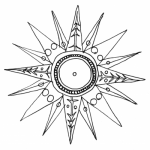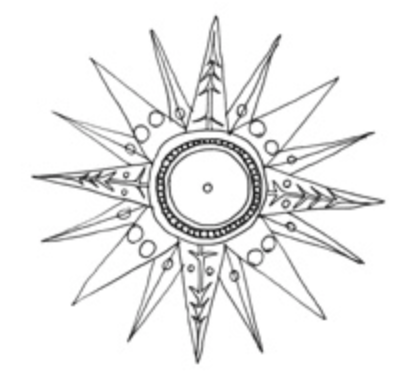*For a simple and efficient tool to help you find harmonics and multiphonics, download the new CELLO MAP APP
▶︎DEFINITION
I define a multiphonic as: as a single excitation by which two or more harmonics sound distinctly and simultaneously on one string.
▶︎THE CELLO MAP APPROACH TO MULTIPHONICS
There are many multiphonic possibilities on the cello that are yet to be discovered. Here, I have identified some multiphonics that work well on the cello and some possibilities for (sometimes unstable) multiple sounds. I firstly present the multiphonics and multiple sounds, and describe the technical parameters that produce them. Then, a more detailed spectral analysis gives a deeper understanding and points to new directions.
▶︎▶︎NOTE
Because there are so few precursors for multiphonics research, I set out some questions that I consider key to performers and composers, to help guide our work.
▶︎IMPORTANT SOUND-ELEMENTS OF MULTIPHONICS
Pitch content
- – Which harmonics sound?
- – Which other pitches/pitched noises/unpitched noises are important aspects of the sound?
- – What is the balance in loudness between the harmonic components?
Flexibility in loudness and timbre
- – How loud/soft can the multiphonic be played?
- – How much can the timbre be varied?
▶︎IMPORTANT PRACTICAL ASPECTS
Notation
- – Can multiphonics be categorised in a table/fingering chart?
- – How can multiphonics be notated in a score?
Difficulty rating
- – How easy is it to reproduce a multiphonic in a musical context?
- – How reliable will multiphonics become through practice?
▶︎GENERAL INFORMATION
Multiphonics seem to occur when harmonics with nodal points closely situated on a string are encouraged to sound together by making some compromises with left-hand position, bow speed/pressure and point of contact. In other words, the player finds a left-hand position, bow speed/pressure and point of contact that is ‘acceptable’ enough to several harmonics to enable them to sound simultaneously.
The sound quality of multiphonics can vary from pure, to rough and unstable, and there is some flexibility in loudness. Reliability in reproducing multiphonics improves, I have found, with practice and is easier when the pitch and the fingerboard position of the component harmonics are clear to the performer.
▶︎METHODOLOGY
I have not tried to make a definitive list of all possible multiphonics; the technique is not yet well enough understood by musicians or acousticians. Therefore, I adopted a strategy to identify all possible multiphonics within certain limits.
I decided to limit my search to multiphonics containing only the 2nd to the 13th harmonics. I sketched a scaled version of a cello string labelled with the harmonic nodes 2 to 13 (see figure).

I worked at the cello, starting at the harmonic node closest to the nut, trying to encourage harmonics with neighbouring nodal points to sound simultaneously by altering bow speed and pressure. The combinations of harmonics 2-13 that could be induced to sound together in multiphonics are shown in the string sketch below.
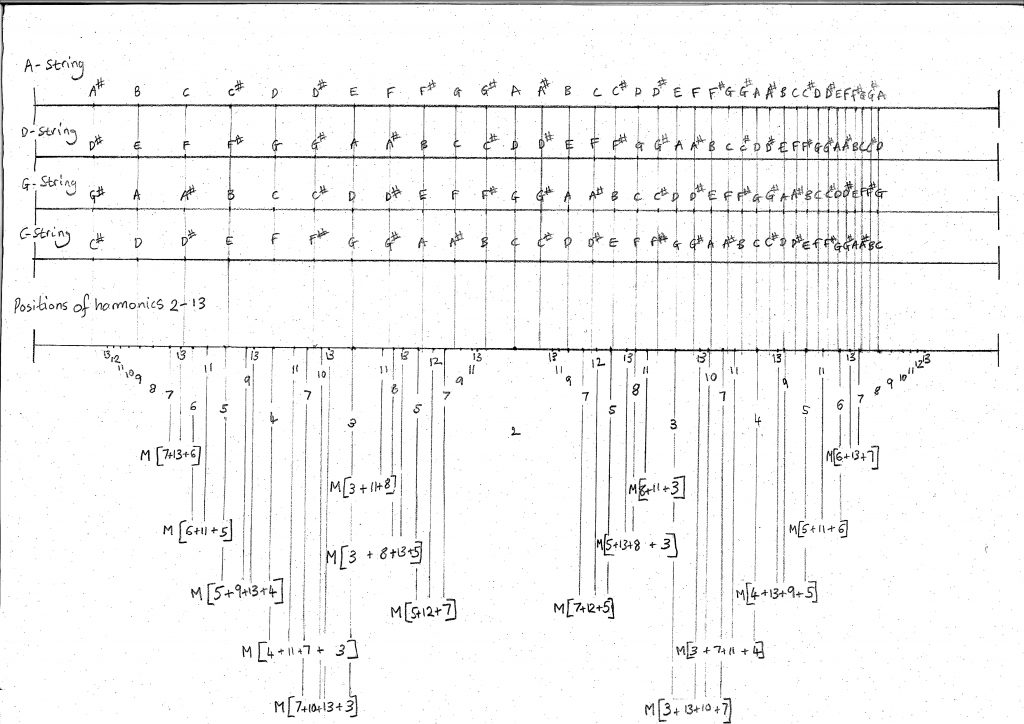
Observing the pattern of the first 13 harmonics on the string
The pattern of harmonic nodes on the string is symmetrical about the string’s mid point. If only the first 13 harmonics are considered, then, at the nut and the bridge, the harmonic node numbers descend incrementally (13, 12, 11, 10…) until the 7th harmonic node, after which the node number fluctuates (7, 13, 6, 11, 5…). This can be seen in the figure. This point where the node number starts to fluctuate is key; it is the beginning of a region of ‘pure’-sounding multiphonics (to be discussed below).
▶︎▶︎NOTE
There are two equivalent positions for each multiphonic
It is clear from the figure that the organisation of harmonic points is symmetrical about the string’s mid point. Therefore: every multiphonic can be produced at exactly two positions on the string. These two positions will be on opposite sides of the string’s mid point and equidistant from it.
▶︎TECHNICAL COMMENTS
In general, to perform a multiphonic, I play with light left-hand finger pressure and a medium-slow, fairly heavy bow stroke, further from the bridge than for normal harmonic playing. These conditions are relative to the ‘usual’ playing technique for the highest harmonic that contributes to the multiphonic, so they vary from multiphonic to multiphonic: the bow stroke will be lighter, faster and closer to the bridge if the multiphonic contains high components (e.g., 12th, 13th harmonics) than for multiphonics with only mid-range harmonics.
▶︎MULTIPHONICS THAT INCLUDE HARMONICS 2-13:
The following is the result of my strategic search for multiphonics on the cello.
Pure multiphonics
I found eight ‘pure’-sounding multiphonics. They are quite stable, with a pure sound and well-balanced (equally loud) harmonic components. They are shown in the table and their position on the string is shown in the string sketch.
To label the multiphonics, I use M to mean a general multiphonic on any string or the string number in roman numerals to denote specific strings (I, II, III, IV). Then, the numbers of the contributing harmonics appear in square brackets, ordered according to their position on the string. For example:
M [6+11+5] is a multiphonic on any string that includes the 6th, 11th, and 5th harmonics, III [6+11+5] is a multiphonic on the G string that includes the 6th, 11th, and 5th harmonics.
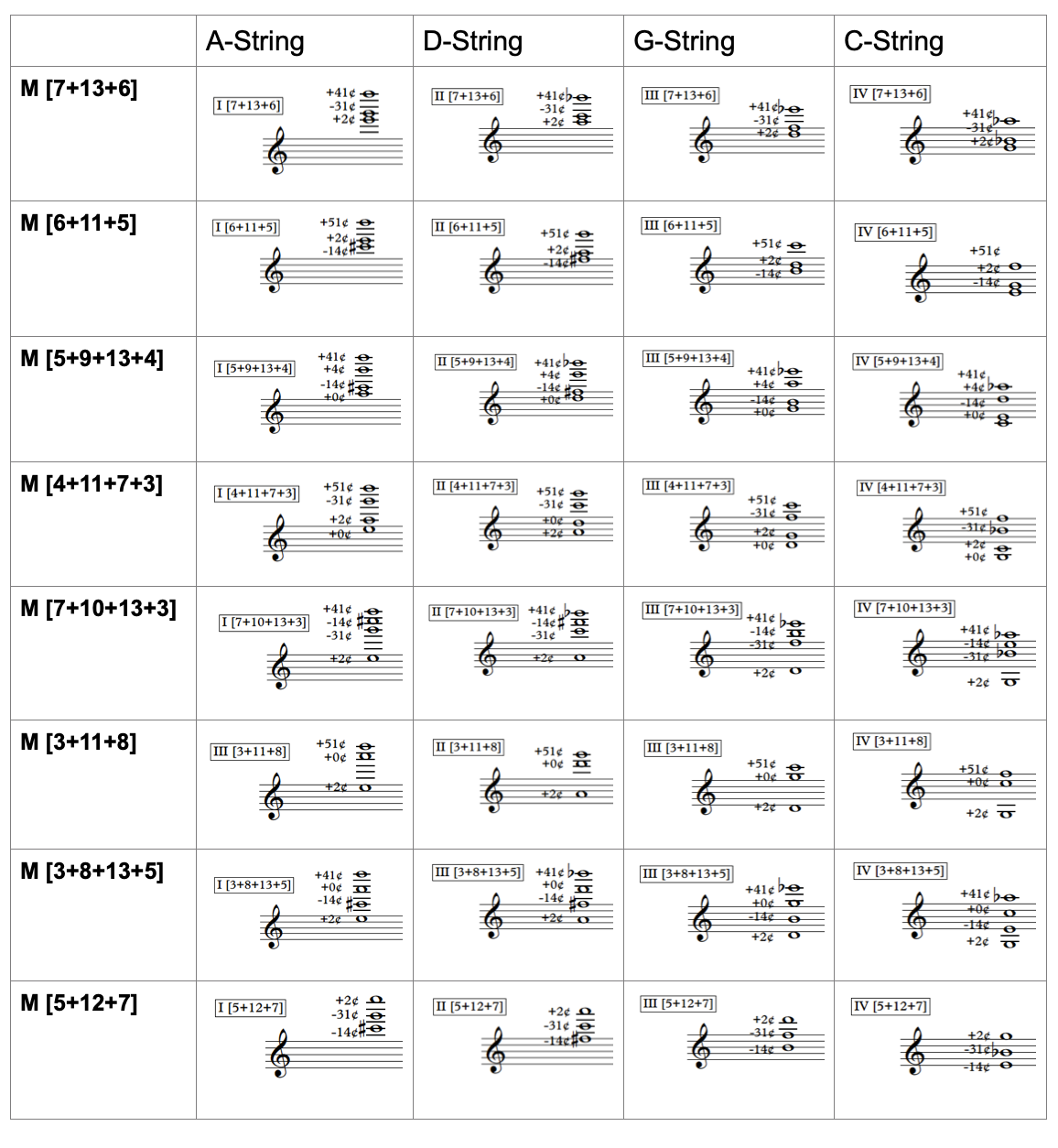
Each multiphonic can be produced at two points, in the upper and lower halves of the main part of the string. These two points are located symmetrically around the middle of the string. In the string sketch, the order of the harmonics in the square brackets is opposite for the lower and upper halves of the string, because they appear in reverse order, i.e., the upper half of the string is a mirror image of the lower. For example, M [3+11+8] in the lower half of the string becomes M [8+11+3] in the upper half. In general, the position that is in the lower (nut-to-mid point) half of the string is easier for the cellist to find because stopped-string pitches can be used as reference points on the fingerboard.
▶︎NOTATION
The above notation (e.g., M [3+11+8]) is useful for labelling multiphonics, especially in a table or fingerboard sketch similar to that above. To notate ‘pure’ multiphonics accurately in a score, however, it is necessary to indicate both the left-hand finger position and the pitch content. The left-hand finger touches the string above the node of the highest harmonic that contributes to the multiphonic, so the finger position is always that of the highest harmonic in the group. I suggest notating finger position with the rhombus that is usually used for harmonic finger pressure. The pitch of the contributing harmonics could be notated in brackets or on a separate stave. It is necessary to indicate which string the multiphonic should be played on and helpful to use the indication ‘M’ for multiphonic.
For example, to notate the multiphonic II [4+11+7+3] in the lower half (nut-to-mid point) of the string:
Finger position is at the node of the 11th harmonic (this is the 3rd of 10 nodes for the 11th harmonic), which corresponds to a stopped string pitch of a quarter-tone sharp G3. The resulting harmonics are the 4th, 11th, 7th and 3rd:
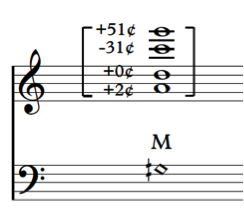
The string sketch above can be used to find the approximate location of the multiphonics on the string relative to the position of a stopped-string pitch (remember, use the touch point of the highest contributing harmonic). Alternatively, the exact touch points, which I calculated more accurately using the algorithm shown in the harmonics section of cello map, are shown in the multiphonic fingering charts on the next page.
The videos show the eight ‘pure’ multiphonics in the lower half of each string (nut-to-mid point). For the G-string, we also recorded the corresponding eight multiphonics in the upper half of the string (mid point-to-bridge). I firstly play each of the harmonic components of the multiphonic, in the order that they appear on the string, and then the multiphonic itself.
Multiphonics A String
Multiphonics D String
Multiphonics G String
Multiphonics C String
Fluttering and noisy multiphonics
There are some multiphonics at each end of the string, with incremental nodal components. These are relatively unstable and have a ‘fluttering’ sound quality. Similarly, there are some multiphonics around the string’s mid point, which are fairly unstable and noisy. These multiphonics have a different character to the ‘pure’ multiphonics and the pitch and noise outcome is much less reliable. It is necessary to ‘force’ these multiphonics to sound by using high bow pressure. They will be discussed in more detail in ‘Other multiple sounds’.
▶︎CONTROLLING LOUDNESS AND OVERTONE CONTENT
The scope for varying bow pressure, bow speed and point of contact in multiphonics is limited compared to normal playing, and even compared to performing harmonics. In general, these factors control the loudness and noisiness of a multiphonic. However, they also influence which harmonics take part in a multiphonic and can block high/low components. Therefore, when trying to change the loudness or colour of a multiphonic, it is very easy to ‘break up’ the multiphonic and find yourself playing a single harmonic. A balance between flexibility of colour/loudness and reliability of multiphonics is difficult to achieve. In summary:
- – Increasing bow pressure increases loudness and encourages a distortion-like sound. High bow pressure favours the lower harmonics, making them loudest in the mix of harmonic components. It also encourages the open string (‘first harmonic’) to contribute to the sound and can restrict high harmonics.
- – Decreasing bow pressure makes a multiphonic sound quieter and ‘purer’. Low bow pressure can restrict the lower harmonics in a multiphonic.
- – Increasing bow speed increases loudness and encourages higher harmonics, eventually cutting out lower harmonic components.
- – Decreasing bow speed decreases loudness and encourages lower harmonics, eventually cutting our higher harmonic components.
- – Contact points quite close to the bridge encourage noisiness and favour low components, sometimes restricting high harmonics and allowing the open string to sound.
- – Contact points very close to the bridge produce a ‘purer’ sound and favour high components, sometimes restricting low harmonics.
▶︎TECHNICAL PARAMETERS: LEFT HAND POSITION, BOW SPEED AND BOW PRESSURE
I found that a reliable method for producing multiphonics is to play the highest harmonic component first and then decrease bow speed and increase bow pressure to encourage neighbouring harmonics to sound. In some cases, shifting the left hand finger position so that it lies between two harmonics is also necessary. However, in my experience, the right hand seems to have more control than the left in producing multiphonics. The string seems to be ‘forgiving’ if the left hand is slightly out of alignment with the node: cellists are aware of this phenomenon when playing single, natural harmonics, e.g., the 3rd harmonic still sounds if the finger touches the string 1 cm away from its node. Bowing conditions are more critical to harmonics, especially high harmonics, and it follows, therefore, that they are the controlling factor in multiphonics.
The left-hand finger position seems, however, to be more important for multiphonics located at the very ends of the string. In fact, I noticed a differentiation between the playing technique and sound of multiphonics found at the very ends of the string and in the main part of the string. At the ends of the string, where the harmonic numbers follow one another incrementally, the left-hand finger needs to be quite flat and completely covering two or more nodes (perhaps even turned slightly diagonally so that it covers a larger portion of string length). The bow stroke is heavier and slower, and less variation in playing conditions is possible. The sound is quite distorted. The open string often sounds alongside the harmonics and the harmonic components sometimes have a ‘fluttering’ quality, as if they are being played successively, very fast. In the main part of the string, where the harmonic numbers are mixed (e.g., 6 + 13 + 7), the sound is purer and there is more scope for using the bow to vary colour and loudness.
The two positions for each multiphonic are not exactly equivalent
As I mentioned above, there are two positions for each multiphonic: one is on the upper half of the string, on the nut side and the other on the lower half of the string, on the bridge side. These two positions are equidistant from the string’s mid point. Although these are theoretically ‘equivalent’, there are slight differences in playing technique and sound. In fact, the difference in sound between equivalent nodes of a single, natural harmonic has not yet been fully understood. The position of the finger relative to the bow seems to play a role, as does the differences in flexibility of the string at the nut, bride and mid point. The pitch of the string were it to be pushed to the fingerboard rather than touched as a harmonic also seems to contribute a colouristic effect, even a perceivable pitch. These factors also play a role in differentiating between theoretically ‘equivalent’ multiphonic positions. This is experienced as a difficulty in producing multiphonics whose position is close to the bridge. The harmonic components seem to be ‘too stable’ and less willing to sound together in the more fragile multiphonic situation. To get around this, multiphonics in this region can be played with the bow ‘behind’ the finger (i.e.,the finger is between the bridge and the bow). Using this technique, multiphonics are more stable and the open string can easily be introduced into the sound, without breaking up the component multiphonics. The pitch between finger and nut is often also present as a low, distortion-like colour. This is effectively an ‘overpressure-harmonic’, which will be discussed in more detail in the next section.
▶︎MORE INFORMATION
To find out more about multiphonics for cello and other stringed instruments, see the Special Issue of Tempo ‘The Art of the String Multiphonic’ here.
CELLO MULTIPHONICS: TECHNICAL AND MUSICAL PARAMETERS (Read Only)
Tempo -Volume 74 – Issue 291 – January2020 ‘The Art of the String Multiphonic’
